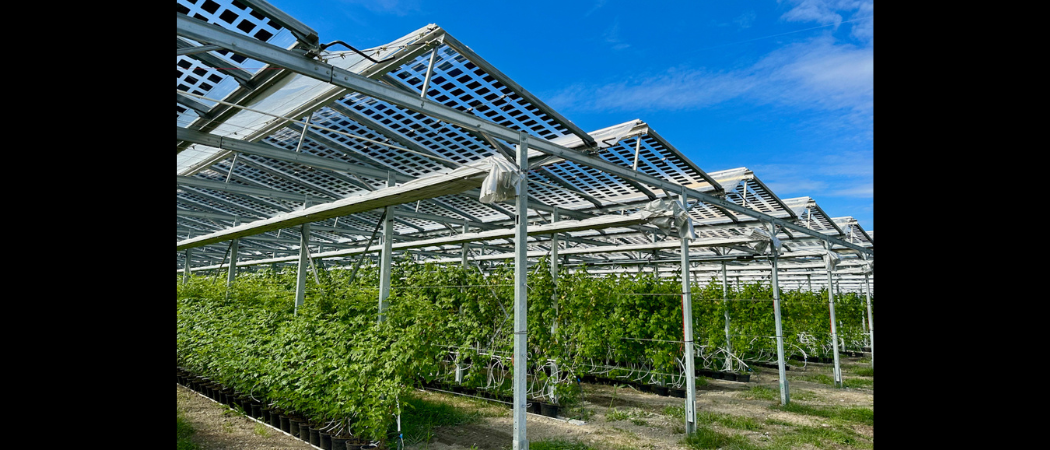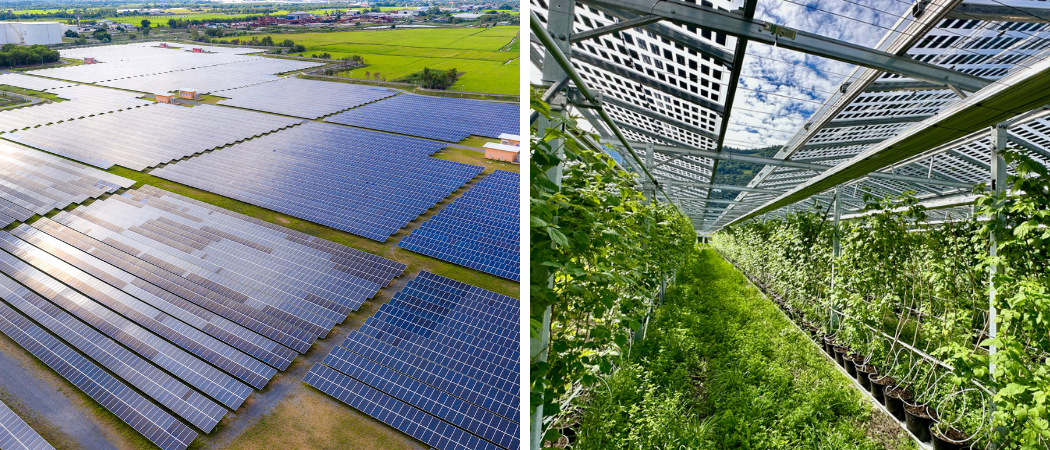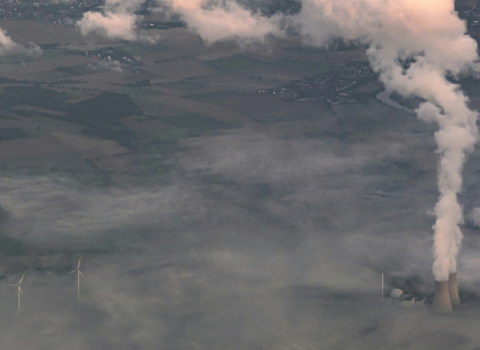By combining farming and solar panels, agrivoltaics promises the best of both worlds. Large pilots are up and running, but now regulation must catch up with technology if Europe is to reap the benefits

Insolight’s agrivoltaic system replaces protective netting over crops such as raspberries, growing here at Conthey in Switzerland. Photo: Insolight
Combining the production of food with the generation of electricity - by installing photovoltaic panels amongst or over crop plants - should be a ‘no-brainer’ for the EU, increasing renewable energy generation whilst supporting agriculture.
A recent report by the European Commission’s Joint Research Centre, says having such agrivoltaic systems on just 1% of agricultural land in the EU could get the bloc past its 2030 target for solar energy generation. Add more land, and the gains keep growing.
“We have a tremendous opportunity for deploying solar installations at scale,” said David Schuppisser, chief commercial officer of Insolight, one of a number of European start-ups targeting this relatively new market. “We only have to choose which one or two percent of the land we wish to allocate to agrivoltaics.”
But the practice of leasing farmland to install massed ranks of panels is contentious. Some see it as an eyesore, others are concerned that it is taking agricultural land out of production. Many European countries have banned the practice for standard solar panels.
However, agrivoltaic systems offer a way of maintaining crop production without greatly changing the landscape. In the case of speciality crops, broadly covering fruit, vegetables and ornamental plants that are commonly grown under some form of protective structure, whether a polytunnel, greenhouse or shading nets, these are replaced with structures that provide the same protection, but also have semi-transparent solar panels to produce electricity.
“You don’t need to sacrifice the countryside or full agricultural land, you can do agrivoltaics in a smart way,” Schuppisser said.
The problem is that regulations for land planning and the rules for agricultural and energy subsidies often do not recognise that food and energy production can complement each other rather than compete. “The main challenge for all agrivoltaic solutions is that you are between two worlds,” said Nicolas Weber, co-founder and chief executive of Swiss start-up Voltiris. “When we look at subsidies, for example, they are not adapted to what we do, and the legal frameworks are extremely slow to adapt.”
Schuppisser also cites regulatory uncertainty is the biggest challenge in scaling up. “Currently agrivoltaics are a very new area, and the technology is somewhat ahead of the regulations,” he said. “The regulators are taking their time to authorise projects. There is a lot of uncertainty around what you can build where, and every country is taking its own approach.”
This is complicated by fragmentation in decision making. “We are dealing with this country by country, and sometimes region by region, depending on the level at which decisions are taken,” he said.
Greenwashing projects
A common concern is that there is no clear definition of what constitutes an agrisolar project. This is necessary to ensure that regulations on planning are applied consistently, and so that appropriate economic support can be formulated.
In the Netherlands, for example, the government has said it will no longer give permits for standard solar parks on agricultural land, in order to protect food production. Agrisolar (also known as agri-photovoltaics, or agri-PV) is permitted, but with no clear definition there is nothing to stop developers trying get solar parks with a bit of agriculture around the edges, through planning permission.
“If you get greenwashing projects, and things go wrong, then agri-PV could get a bad name and that could hinder its implementation in the longer term,” said Wilma Eerenstein of the Renergize consultancy, which is coordinating Sunbiose, an agrivoltaic test project in the Netherlands.
Definitions also need to be accepted by the people who manage land designations, so that farmers hosting agrivoltaic systems do not lose their agricultural subsidies. “Each country is re-inventing the wheel,” Eerenstein said. “It would help if there was a European definition and European legislation on how to deal with the designation of the land, so that farmers are still eligible for Common Agricultural Policy support.”
Finally, the contract price paid for agrivoltaic energy needs to recognise the higher costs involved. Typically, the structures are higher than conventional ground solar panels, so construction is more expensive. In addition, the power density is lower, because the panels are semi-transparent. “So you have higher costs and lower kilowatt-hour production,” Eerenstein said, “and that means to get a feasible solar business case you need a slightly higher tariff for the generated power.”
Agrivoltaic technologies are currently at various stages of development, from experimental to commercially available.
Insolight, for example, has several large-scale commercial pilots in France, Switzerland and Italy for speciality crops. In addition to replacing greenhouses or polytunnels, the pilots have sensors that continuously measure climate conditions and feed information to a control system so that a shading layer can be deployed for additional protection, which at the same time boosts electricity production. “We aim to minimise the impact of electricity generation on the crops, and in some cases we can maintain or increase yields,” said Schuppisser.
This is because the crop protection provided is much more adaptable than simple shading. “Our installation can adapt to the crop, optimising the micro-climatic conditions,” said Schuppisser. “We see tremendous potential there for providing solutions which protect the crop against variations in the weather, against climatic extremes, and which allow production to become more resilient.”

Decision matrix
Deciding where to deploy agrivoltaic systems is a balancing act. “It’s a complex decision matrix between the crop, your geography and how much shade you can bring to the crop,” said Schuppisser. “A lot has already been done on the infrastructure side, but there is more to be understood about crop modelling and accumulating data around how crops develop and can perform under agrivoltaic systems such as ours.”
This is where projects such as Sunbiose come in. A four-year project funded by the Dutch government, it aims to test and further develop agrivoltaic systems in a range of settings. These include roof coverings for soft fruits (strawberries, raspberries and red berries) and pear trees, a movable arch combined with grass/clover and strip cultivation, and a photovoltaic construction in combination with field crops.
“The project is about the technical feasibility of the PV constructions, but is also intended to determine the impact on crop growth and crop quality,” said Eerenstein.
This goes to the heart of the feasibility of deploying agrivoltaic systems. “As soon as you take some light away from the crop there is an impact on crop yield, but also on the sugar content on the fruit, for instance,” she said. “We have a lot to learn about that, how it impacts different crops and what level of transparency is needed for growers at different latitudes.”
Strawberries have not fared well in the Sunbiose pilots. “In that case the grower said the drop in yield was too much for feasible strawberry production, and he did not want to continue with the pilot,” Eerenstein said.
The lower yield might be less dramatic for growers further south, and in the longer term there may be technical fixes that could improve yields in northern countries. For example, coatings are under development that absorb UV light, a wavelength not used by the plants for photosynthesis or by the panels for electricity generation, and then re-emit the light in parts of the visible spectrum that plants can use.
Developing plant varieties more tolerant of shade, which will be better adapted to agrivoltaic systems, is also a possibility, but not an immediate solution given the long timescales involved in selective breeding programmes. “Plant breeders work on a different timescale from us,” Schuppisser said. “Today it’s about seeing what’s out there and finding the best adapted species.”
Projects such as Sunbiose will need to run over several years, picking up how the systems handle annual variations, or if there are changes to growing patterns of perennial plants. “For pear trees, for example, we can see that the number of flowers varies, so you then need to adjust the way you prune the trees, and we are looking into that as well,” Eerenstein said.
There is also scope for further innovation in this sector, and for new start-ups to emerge. “The use of vertical panels with arable crops is a good candidate, and there are already a few start-up companies there,” Eerenstein said. “And in terms of solar panel production, the semi-transparent panels are still relatively expensive compared to standard panels. Particularly in combination with smart coatings, such as UV-shifting coatings, there is certainly room for start-ups.”
Solar power without shade
Voltiris, founded in 2022, is one of these new entrants. Its system is installed inside greenhouses rather than replacing the glass overhead. The light passes through the glass as usual, then meets a series of light-splitting mirrors. These let through the light in the wavelengths needed for photosynthesis, but direct the remaining light to solar panels for electricity generation. The result is solar power without shading.
Voltiris has carried out 12 pilot projects over the past two years on crops such as tomatoes, cucumbers, peppers, and basil. These have taken place in Switzerland, the Netherlands, France, Spain and most recently the US.
“We’ve demonstrated that the solution works on the agronomical side, we have good data on the energy side, and the next year will be about scaling up the size of our installations so that we are working at the hectare level,” said Weber.
Voltiris expects to have an easier time with regulation than most agrivoltaic companies, since its system is installed within existing structures, without the need for building permits or changes to land use designations. “Once we have the green light from the grower it is fairly straightforward. In the best cases, it can be operational in three months, and the average is four to five months,” Weber said.
However, financial support for the sector could be more effective. “When we look at applying for subsidies, they do not fully capture the value that we provide to the system holistically,” Weber said. “What we would like is not just to have energy subsidies and agronomical subsidies, but to allow the two to be combined.”
Weber thinks that there is still room in the market for new entrants. “Agrivoltaics is a big field, so there is space for many more applications with new technologies, for new crops and different locations.”
And once the regulatory system is improved, the sector should pick up speed. “There is still a lot of room for innovation on business models in this market,” Weber said. “Adoption is still quite slow, because of the time it takes to develop projects and get building permits. Once the regulatory framework eases up, I think then other companies will come forward with much faster approaches.”
Elsewhere in the Ecosystem…
- US gene analysis company Illumina is to its divest cancer testing company Grail, following backing in the US Court of Appeals for a Federal Trade Commission finding that the merger was anti-competitive. The separation should satisfy European Commission demands that the merger between the two companies be reversed over concerns it would stifle innovation and reduce choice in the emerging liquid biopsy market.
- Following success in the pilot phase, the European Institute for Innovation and Technology has decided to continue the EIT Higher Education Institutions initiative until 2027. The 65 projects in the pilot have created new start-up support infrastructures on campuses, new guidelines for research, commercialisation and intellectual property strategies, and new curricula.
- Two spin-outs from the Université Catholique de Louvain in Belgium have signed venture debt agreements with the European Investment Bank. Novadip, a joint spin-out with St Luc University Hospital, will receive €18 million to further develop a bone tissue regeneration technology for rare inherited diseases. Akkermansia Company, a joint spin-out with Wageningen University in the Netherlands, will receive €20 million to accelerate R&D on Akkermansia muciniphila, a bacterium which promises to benefit the gut microbiome.





 A unique international forum for public research organisations and companies to connect their external engagement with strategic interests around their R&D system.
A unique international forum for public research organisations and companies to connect their external engagement with strategic interests around their R&D system.